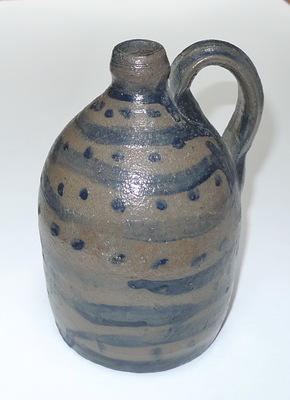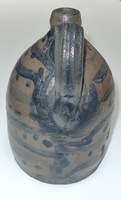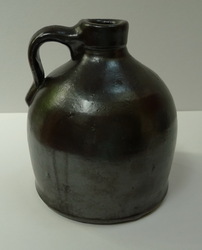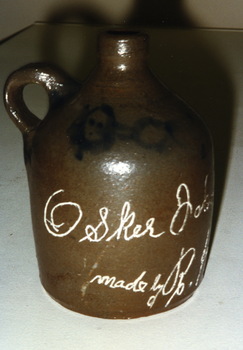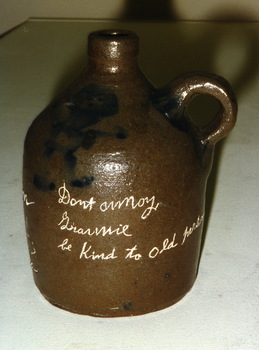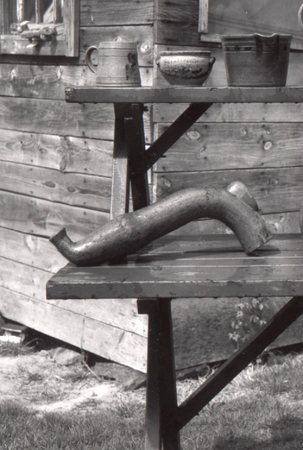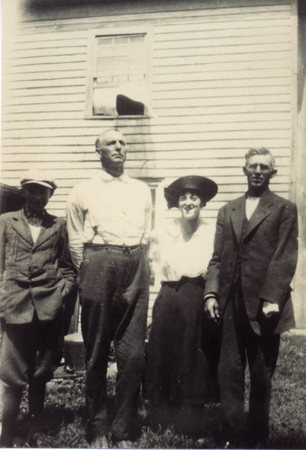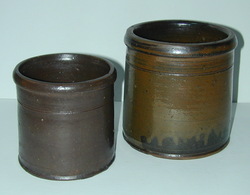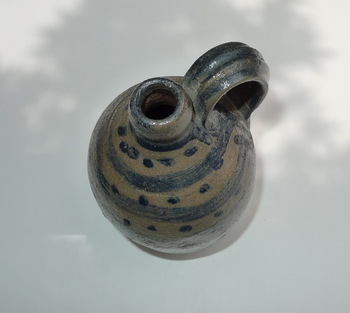Richard Henry Decker
“DICK”
December 22, 1865 – October 1, 1950
POTTER MUSICIAN
FARMER MERCHANT
SAW MILL OPERATOR
Of the four Decker sons Dick, the youngest, is the easiest to write about. This is partially true because he and most of his family “stayed home” in the Chucky Valley. They continued to farm the Decker land, lived in Decker houses, and ultimately inherited the property after the death of Charles Decker, Sr. in 1914. It is also partially because he outlived his brother Fred by fourteen years and his half-brothers Charles and William by over forty years. As this is written many older people in the area remember Dick Decker, although not necessarily as a potter. He is best remembered for his talent as a musician and for his generosity in sharing his music with the neighborhood.
He picked the banjo and guitar with great skill and played the mandolin with equal facility. However, it was his mastery of the fiddle which brought him the greatest acclaim. The late Mrs. Sue Brown Pierce who lived across the river remembered being allowed to go and watch the dancing at the Decker pottery as a young girl. Though too young to dance, she related in detail how the main turning room was cleared on Saturday nights and Dick Decker and his fiddle had the young people of the valley dancing till midnight. She also remembered her punishment the night she stayed too late and arrived home after the appointed hour. She treasured a little jug which she said Dick Decker made for her and which had her name and the date 1895 inscribed upon it. (Ills. 5 and 6na)
Dick was a boy of only six or seven when the family arrived in the Chucky Valley and he grew up with the river on one side for fishing and swimming and the mountains on the other for hunting and trapping. However, we can be sure that Papa Decker found plenty of chores on the farm and around the pottery and store to keep his youngest sons Fred and Dick out of too much mischief. The active life and hearty food caused Dick to grow tall. In fact he grew taller than any of his brothers and he remained proud of his height all of his life. A study of family pictures reveals that he stood ramrod straight every time a camera was pointed his way.
Whether his height, his music or his fun-loving personality caught the eye of Hester Duncan we can only guess but their marriage was a happy one and six girls and three boys blessed their union. Of the five still living in 1990 three live on the original Decker land. A sprightly eighty-nine, Lutora Decker Barnes describes her attendance at the opening of the Decker pottery exhibit at the Tennessee State Museum in Nashville as “the best time I ever had.” At eighty Bill Decker still runs his store and oversees an airport for small private planes which is operated on his land across the road from his home and store. Harry Decker, seventy-seven, actively farms the land beside the airstrip. Another daughter, Bella Decker Phipps, lives just across Taylor Bridge about one mile away.
While Dick Decker is best remembered in the valley for his musical talent, those of us who admire pottery will remember him for the signed pieces which he left for us and those he made for two of his daughters. That he liked children is evidenced by the little jug made for Sue Brown Pierce. No one now living can remember another youngster in the area named Osker Johnson but we can assume that he was something of a pest, at least to his grandmother. The little jug shown in illustrations 7si and 8si shows that it was made for Osker by “R.H.D.” and it is decorated with two “stickmen” done in cobalt blue. Beneath one of them Decker added this admonition to his young friend, "Don’t annoy Grannie, be kind to old persons.”
Of course Dick’s fondness for children was centered in his own family and the very attractive little bank shown in illustrations 9na and 10na was made for his daughter Lena (or Leana) in 1900 when she was three years old. Shaped like an early beehive, it finally made a journey to California with one of Lena Miller’s sons. He and his brothers donated it to the Tennessee State Museum in their mother’s memory and Irene Miller hand carried it back by plane. Lutora Decker Barnes has a similar one made for her by her father on November __, 190_. See illustrations 11na and 12siBB. The differences are the peaked top and the incised horizontal line on Lena’s and the button top and the double wavy lines on Lutora’s. It seems highly likely that similar banks were made for the other three girls but apparently they did not survive. Incidentally, pottery records contain no reference to the making of pottery banks of this type for sale and the two shown here must be regarded purely as labors of love for his daughters.
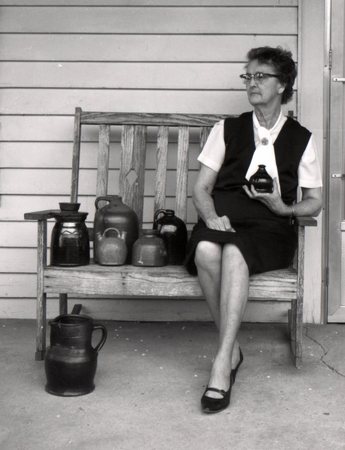
Lutora Decker Barnes holding the bank bearing her name and birth date, Lutora Nov. 20 1901. illus12siBB.
Like Osker Johnson, no one in the family or in the Chucky Valley has any recollection as to the identity of C.R. Bean. Whoever he was, he must have been a very special friend of Dick Decker. On August 17, 1885 when he was only twenty years of age Dick made a beautiful and profusely decorated jug for Bean. Instead of incising the names and dates in the damp clay by hand, as was almost always the practice by all of the Deckers, he used block type similar to that used on the Decker grave markers. With the exception of the two large yard ornaments made by his father and oldest brother, this jug is the ONLY piece seen in which professionally made type was used. (Editor’s note: Beverly overlooked Charles, Sr.’s masterpiece seen in Burbage3 and ai20.) Cobalt blue tulips were painted all around the jug and there is a blue ring around the neck as well as a blue handle. It is a beauty! See illustration 13na which really does not do it justice.
Although a careful check of the surviving pottery records does not disclose any detailed listings of pottery made by Dick Decker, we must remember that those records taken together do not cover more than a third of the total number of years in which the Keystone Pottery was in operation in the valley. Study of the three jugs and two banks which we know he made shows that they were turned by a skilled and practiced hand. Surely he is responsible for a share of the unmarked pieces which were produced in quantity and we can hope that more signed pieces may surface in the future. He also took his turns in the store and on the farm. Too, there was wood to be cut for the kiln and clay to be dug, processed and made ready for turning. One wonders how he found the time to master four instruments and make a reputation throughout the county as a master fiddler. Incidentally, if the family had remained in Pennsylvania he might have become known for his skill with the violin but as the family came south the name of the instrument was changed to fiddle! The music changed as well and the Saturday night “shindigs” in the Decker pottery buildings saw the people of the valley square dancing and doing the Buck and Wing to tunes such as “Turkey Buzzard,” “Sourwood Mountain,” “Sally Ann,” “Hole in the Kettle,” “Shoot Ole Davey Dugger,” “Sally Goodin,” and “Natchez Under the Hill.”
His daughter, Lutora, loyally says her father was “the greatest fiddler in the world,” but this description might well have offended the Decker’s next-door neighbor, Congressman (and later Governor) Alfred A. Taylor, who was a well-known fiddler in his own right. His brother, Robert Love Taylor, a three-time governor, a senator, a congressman, a talented fiddler, and a frequent guest of his brother, might also have been unwilling to concede such a title to neighbor Dick Decker. However, no such rivalry existed and the three enjoyed summer evenings “fiddlin” under a large tree in Alf’s front yard. The Taylors were famous sons of a pioneer Tennessee family which had been leaders in the military, in government, and in social progress. One might wonder what they had in common with the son of a German immigrant who spent his days in pottery rather than politics. The magnet was music and the respect and admiration each felt for the talents of the others. On occasion Alf joined Dick Decker in playing for local dances and Dick observed firsthand the way the Taylor brothers coupled their fiddling skills with their oratory in their political campaigns. All of the Deckers witnessed the start of Tennessee’s most famous political contest in which Republican Alf squared off against Democrat Bob in a race for governor. The campaign quickly became known as “The War of the Roses,” the name coming from an earlier contest between brothers for the throne of England. In the 1886 contest in Tennessee fiddles took the place of swords and crossbows, and while the campaign was very spirited it was conducted with great civility and much humor. Lively tunes were used to draw a crowd and each brother used eloquent phrases to make his case with the voters. The Taylor brothers traveled the state in a buggy, each with a suitcase and his fiddle. In the end Bob won and Alf and his fiddle came home to the Chucky Valley, his family and his farm. He also came home to the river for he, like the Deckers, loved every ripple as it ran its course past the two farms. Although the Deckers might not have managed so eloquent a description, they would surely have agreed with Alf’s tribute written one spring: “Swollen it was, the dear old Chucky, from late winter thaws and spring rains, darkly turgid, not a broad river nor deep, but quick with fish, frog and crawdad, plenty of warm pools to swim in and narrow passages to swing across.” Of the several Deckers, Dick loved the river more and enjoyed it longer than his three brothers combined. This too cemented his friendship with Alf Taylor.
The histories of the Taylor brothers all describe their love of fox hunting in Happy Valley, their boyhood home in nearby Carter County. Few of them mention the fact that when Alf moved his family to his Chucky Valley farm, his fox hounds came with him. Soon the baying of the pack echoed from the side of Embreeville Mountain as Alf and his friends followed on horseback until heavy growth in the coves at the foot of the mountain forced them to go on foot. Dick Decker was frequently in the party of hunters and he learned that it was difficult to call in the dogs from rugged terrain where the wily foxes often took cover. Using a length of drain tile he fashioned a mouthpiece at one end and curved the other end so it would project the sound in the desired direction. The result was a hunting horn with a rather doleful tone, not unlike a foghorn, which carried a surprising distance in the still night air. See illustration 14siBB. It was found in a shed beside Dick Decker’s house where it had gathered dust for many years.
The days of the Taylor brothers and Dick Decker are long gone in the Chucky Valley but late in his life Dick saw to it that two important pieces which are a part of the history of the valley were placed in a substantial building for safekeeping and display. After Alf Taylor’s death in 1911 his family sold the farm and moved away. The buggy in which the brothers traveled in their 1886 “War of the Roses” campaign was left behind and came into the possession of the Deckers. It was taken to East Tennessee State University in Johnson City by Dick and his son, Bill. They also took a large and important “showpiece” urn made by C.F. Decker, Sr. in order that an example of his skill as a master potter might be preserved. Unfortunately, neither piece was placed on permanent display for more than forty years, but in 1990 both could be seen at the Carroll Reece Museum on the university campus.
We might assume that the sweet sounds of the Taylor’s and Dick Decker’s fiddles fell silent in the valley when they died. Happily, that is not entirely true. Today Dick Decker’s great grandsons, Tim and David Decker, are proving that Dick’s talent is alive and well, and they are doing so on Dick’s own fiddle. The instrument is now a bit darker with age but its tone is as rich and full as though still in Dick’s hands.
Editor’s note: only a small number of photographs accompanied the essays. An effort will be made to obtain the missing images for this site. For the present, poor quality images were deemed better than no images. An na indicates that no image was available. An si indicates that it is a substituted image. If the source of the substituted image was Beverly Burbage a BB will be affixed. An ai indicates that it is an added image. If the original source of an added image was Beverly Burbage then Burbage will be added to the image caption.
Copyright 2009-2022, Carole Wahler
Site by GearheadForHire, LLC | v1.0.2
